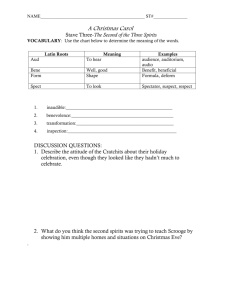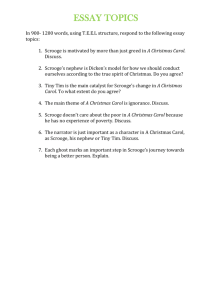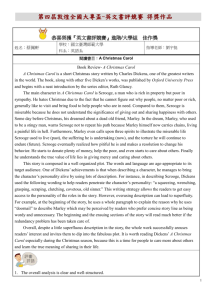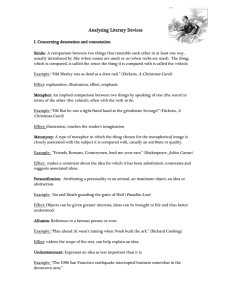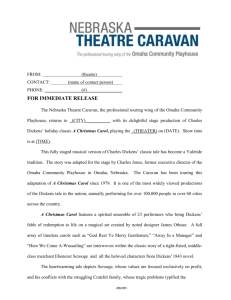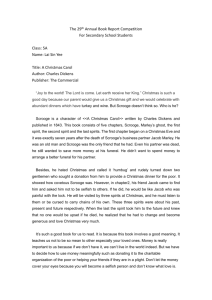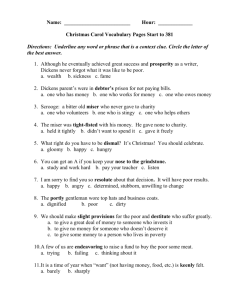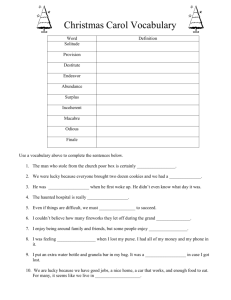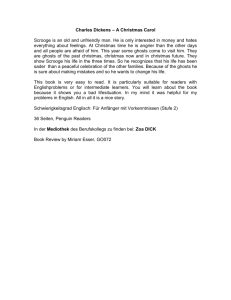A Christmas Carol Study Guide
advertisement
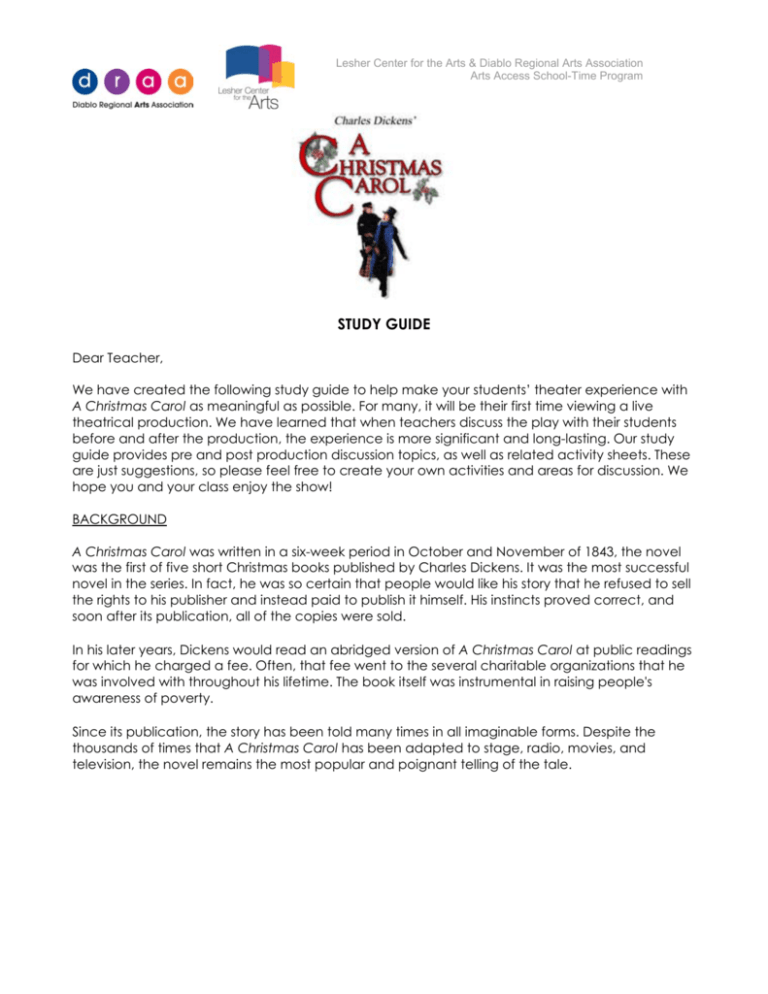
Lesher Center for the Arts & Diablo Regional Arts Association Arts Access School-Time Program STUDY GUIDE Dear Teacher, We have created the following study guide to help make your students’ theater experience with A Christmas Carol as meaningful as possible. For many, it will be their first time viewing a live theatrical production. We have learned that when teachers discuss the play with their students before and after the production, the experience is more significant and long-lasting. Our study guide provides pre and post production discussion topics, as well as related activity sheets. These are just suggestions, so please feel free to create your own activities and areas for discussion. We hope you and your class enjoy the show! BACKGROUND A Christmas Carol was written in a six-week period in October and November of 1843, the novel was the first of five short Christmas books published by Charles Dickens. It was the most successful novel in the series. In fact, he was so certain that people would like his story that he refused to sell the rights to his publisher and instead paid to publish it himself. His instincts proved correct, and soon after its publication, all of the copies were sold. In his later years, Dickens would read an abridged version of A Christmas Carol at public readings for which he charged a fee. Often, that fee went to the several charitable organizations that he was involved with throughout his lifetime. The book itself was instrumental in raising people's awareness of poverty. Since its publication, the story has been told many times in all imaginable forms. Despite the thousands of times that A Christmas Carol has been adapted to stage, radio, movies, and television, the novel remains the most popular and poignant telling of the tale. Lesher Center for the Arts & Diablo Regional Arts Association Arts Access School-Time Program THE STORY The best way to familiarize students with the story of A Christmas Carol is to read Dickens’ original story (or an abridged version for younger readers, of which there are many). The characters in our musical adaptation include the miserly Ebenezer Scrooge; his poor but happy employee, Bob Cratchit; Cratchit’s family, including the frail Tiny Tim; Ebenezer’s loyal nephew, Fred; and, Fan, Scrooge’s late sister (in flashback). The day before Christmas, Scrooge is as surly as on any other day of the year; refusing to see any significance to the holiday, he acts as he always does -mistreating Bob Cratchit, his clerk, refusing to contribute to the local charity, and turning down his nephew’s invitation to celebrate Christmas with his family. Ebenezer insists that Christmas is nothing but “humbug” -- he’s even grateful that it only comes “but once a year.” It is only that night when he is visited by a succession of spirits: the ghost of Jacob Marley (his deceased partner) and the Ghosts of Christmases Past, Present, and Yet-toCome -- that Scrooge learns the consequences of both his past and present actions and reconsiders his point of view. Grateful for a “second chance,” Scrooge vows to help his fellow man – including Bob Cratchit and his little son, Tiny Tim and is reunited with his family, finally accepting his nephew’s offer to share his holiday celebration. Though it all may only have been a dream, Ebenezer Scrooge is a changed man. BEFORE SEEING THE PLAY *Review/Discuss Vocabulary list below. You may also wish to review Charles Dickens’ original story, or an abridged version for younger readers, although it is not necessary in order to understand the play. (Although a film version, of which there are many (see “FOR FURTHER INFORMATION”) would be interesting to compare to the play, we suggest that students view a film adaptation after seeing the play -- to avoid confusion and to preserve the element of surprise!) *Familiarize students with the country and customs of England (Great Britain). Where is it located? How long has the country been in existence? How is Great Britain different than the United States (language? customs?)? Have they ever heard someone speak with a “British accent”? The story was written in the 1840s and takes place in the large city of London. How was the country different at that time compared with the present day? *What do you associate with the holiday season (whatever holiday your family celebrates)? (“Peace on Earth, Good Will Toward Men?”) What special things do you do? Do you eat special foods? Do you visit family? Does your school do something for the community, like collect toys, clothing, or canned goods? Why do you think that people do these kinds of things around this time of year? Watch for the ways that the characters in A Christmas Carol celebrate the holiday. *Discuss the life of Charles Dickens and bring in some of his books. Discuss why he was so famous http://www.online-literature.com/dickens/ *The Genre is Fantasy. Have your students look up the word in the dictionary. Ask your students what it means and have them make a list of other fantasy stories; discuss examples of fantasy and reality. Lesher Center for the Arts & Diablo Regional Arts Association Arts Access School-Time Program A CHRISTMAS CAROL VOCABULARY character: a person represented in a story, drama, etc. conflict: to come into collision or disagreement; be contradictory, at variance, or in opposition; clash plot: Also called storyline. the plan, scheme, or main story of a literary or dramatic work, as a play, novel, or short story theme: a unifying or dominant idea; a subject of discourse, discussion, meditation, or composition ghosts: the soul of a dead person, a disembodied spirit imagined, usually as a vague, shadowy or evanescent form, as wandering among or haunting living persons humbug: nonsense; especially something designed to be deceptive or misleading miser: someone who hoards money greed: selfishness beyond reason Scrooge: a character in the story A Christmas Carol; a miserly person esquire: a title of courtesy used following a gentleman’s name workhouse: institution where poor people were confined because they couldn’t pay their bills counting house: a building or office for bookkeeping and other business transactions betrothed: a promised in marriage or to be engaged scalawag: a rascal farthing: a British coin equal to one fourth of a British penny ha’penny: a British coin equal to one half of a British penny: a half penny wretched: miserable, deeply afflicted odious: hated, repugnant frugal: thrifty, spends money sparingly sixpence: a British monetary unit equal to six pennies shilling: a British monetary unit of small value reprobate: someone who is thoroughly bad Ghost of Jacob Marley: his old partner who died seven years earlier Ghost of Christmases Past: a spirit that takes Scrooge back in time Ghost of Christmas Present: a spirit that shows Scrooge the present day Ghost of Christmas Yet to Come: a spirit that takes Scrooge into the future Lesher Center for the Arts & Diablo Regional Arts Association Arts Access School-Time Program AFTER SEEING THE PLAY As soon as possible after seeing the play, talk about it with your class. Discuss the theatrical elements of the performance. How did the set design, costumes, music, etc., enhance the story? (Example: How did the music help to set the mood?) Who was their favorite character and why? Did they notice which actors played more than one part? How did the costumes help to make the actors look like different characters? What did the actors do (change their voices and accents, or move differently?) to make you think they were different people (or ghosts)? Can a volunteer from the class imitate their favorite character? What was the moral of the story? *A Christmas Carol comprehension questions (see attached) *A Christmas Carol crossword puzzle (see attached) *Jeopardy!: have students create their own jeopardy game *Students can dress up as their favorite character and have a party *Students can view the film adaptation and discuss/write comparisons OTHER ACTIVITIES: Artistic Expression *Create a map or diorama of the setting of the play Creative Dramatics *Have your students re-enact scenes from the play. Simple masks can be made to represent the various characters *Christmas Carols-Find some Christmas carols that you might have heard on a London street in the 1840s. Divide the class into groups and have each learn a different song and present the “carols” to another class or at your holiday party Creative Writing *Writing Prompt: Alternate Endings Have students write their own version of A Christmas Carol, each starting at the same point in the story (such as when Scrooge meets the first ghost). Read essays aloud, comparing each student’s conclusion to the story. (For example, if Scrooge chose not to change his ways, would it happen exactly as the Ghost showed?) Or, if they would prefer, have them write a modern adaptation of the story Lesher Center for the Arts & Diablo Regional Arts Association Arts Access School-Time Program BIBLIOGRAPHY: Charles Dickens was born in Portsmouth, England in February 1812. His father, John Dickens was a spendthrift, and the family moved frequently during Dickens's childhood. At one point they lived in a tiny house in Camden Town that many people believe serves as the model for the Cratchits' house in A Christmas Carol. When Dickens was twelve years old, his father was sent to debtor's prison, and Dickens was forced to quit school and begin working. The sympathy he developed for the poor, especially poor children, is reflected in all of his books. Before becoming a writer, Dickens worked as a law clerk and a newspaper reporter. He began to show promise as a fiction writer by publishing numerous stories in a variety of popular magazines. Finally, in 1836, Dickens married Catherine Hogarth and began writing The Pickwick Papers, the first novel that would bring him a degree of fame. In all, Dickens completed eighteen novels and died in 1870 while writing his nineteenth, The Mystery of Edwin Drood. He is buried in Poet's Corner in Westminster Abbey in London. All of his novels are still in print, and nearly every high school in the United States requires its students to read at least one Charles Dickens novel, but A Christmas Carol is by far his best-loved book, having been translated into more languages, and inspiring more movies, television episodes, and adaptations than all of his other works combined. BOOKS/AUDIO: Blishen, Edward. Stand Up Mr. Dickens: A Dickens Anthology. Jill Bennett, illustrator. New York: Houghton Mifflin Co., 1996. (Contains excerpts from Dickens’ greatest works, including A Christmas Carol, and describes the way the author read them in front of lecture audiences. Great for reading aloud.) Dickens, Charles. Eyewitness Classics: A Christmas Carol. Adapted by Shona McKellar and illustrated by Andrew Wheatcroft. London: DK Publishing, 1997. (Recommended for ages 9-12). Dickens, Mary Angela. Children’s Stories from Dickens. Derrydale Press, 1998. (Stories of children from Dickens’ works written by the author’s granddaughter, including Tiny Tim, David Copperfield, and Oliver Twist.) Film/Audio versions (available on video/cassettes or CD) Charles Dickens’ A Christmas Carol. Simon & Schuster audio, 1994. (An audio recording of Patrick Stewart’s acclaimed oneman version of the classic tale.) A Christmas Carol. Directed by Edwin L. Marin, 1938. (Starring Reginald Owen as Scrooge.) Scrooge. Directed by Brian Desmond Hurst, 1951. (Starring Alastair Sim.) A Christmas Carol. TV version directed by Clive Donner, 1984. (Starring George C. Scott.) Lesher Center for the Arts & Diablo Regional Arts Association Arts Access School-Time Program INTERNET RESOURCES: California Content Standards: http://www.cde.ca.gov/be/st/ss/index.asp A Christmas Carol: Comprehension Questions http://www.easyfunschool.com/article1898.html Charles Dickens: A Christmas Carol http://www.leasttern.com/ChristmasCarol/CCarol.html Dictionary: http://www.yourdictionary.com/ eNotes: A Christmas Carol summary http://www.enotes.com/christmas-carol The Literature Network: http://www.online-literature.com/dickens/ Web English Teacher http://www.webenglishteacher.com/dickens.html CA CONTENT STANDARDS: 1.0 ARTISTIC PERCEPTION Processing, Analyzing, and Responding to Sensory Information Through the Language and Skills Unique to Theatre Students observe their environment and respond, using the elements of theatre. They also observe formal and informal works of theatre, film/video, and electronic media and respond, using the vocabulary of theatre. Development of the Vocabulary of Theatre 1.1 Use the vocabulary of theatre, such as plot (beginning, middle, and end), scene, sets, conflict, script, and audience, to describe theatrical experiences. Comprehension and Analysis of the Elements of Theatre 1.2 Use body and voice to improvise alternative endings to a story Lesher Center for the Arts & Diablo Regional Arts Association Arts Access School-Time Program A Christmas Carol: Comprehension Questions 1. List three things in part one that prove the setting of the story is England, 1843. 2. List each character in the story and their relationship with Scrooge. 3. Explain how Scrooge's lifestyle is inconsistent with his wealth. 4. Who is Marley? What is Marley's relationship to Scrooge? 5. What is Marley's purpose in the story? 6. List several ways that Marley and Scrooge are alike. List several ways in which Marley and Scrooge are different. 7. Using complete sentences, carefully describe the appearances of each spirit. 8. What physical change took place in the spirit of Christmas Present from his when he first appears in the story to when he leaves? 9. Why is the spirit of Christmas present a stranger to Scrooge? 10. Bob Cratchit offers a Christmas toast in Scrooge's honor. Mrs. Cratchit's feelings about Scrooge are different from her husband's. What would cause this difference in their feelings? 11. Using complete sentences, explain the lesson that Scrooge learns from each Spirit. 12. Which spirit was the most frightening to Scrooge? Why? 13. Which spirit had the greatest effect on Scrooge? Why? 14. Scrooge says, "I am not the man I was." Why does he mean? What causes the change? 15. Explain why the visions of the future would convince Scrooge to alter his life. 16. List several changes that took place in Scrooge by the end of the story. 17. How does Scrooge show he is sincere about his promise to keep Christmas all year? 18. Predict what Scrooge's future life will be like. Lesher Center for the Arts & Diablo Regional Arts Association Arts Access School-Time Program A Christmas Carol Crossword 1 2 3 4 5 6 7 8 9 10 11 12 13 14 15 16 17 18 19 ACROSS DOWN 1. a person represented in a story, drama, etc. 3. Also called storyline. the plan, scheme, or main story of a literary or dramatic work, as a play, novel, or short story 10. a title of courtesy used following a gentleman’s name 11. a unifying or dominant idea; a subject of discourse, discussion, meditation, or composition 14. a rascal 15. miserable, deeply afflicted 16. hated; repugnant 17. a promised in marriage or to be engaged 18. the main character in A Christmas Carol; a miserly person 1. to come into collision or disagreement; be contradictory, at variance, or in opposition; clash 2. the soul of a dead person, a disembodied spirit imagined, usually as a vague, shadowy or evanescent form, as wandering among or haunting living persons 4. someone who hoards money 5. selfishness beyond reason 6. a building or office for bookkeeping and other business transactions 7. institution where poor people were confined because they couldn’t pay their bills 8. a British coin equal to one fourth of a British penny 12. a British monetary unit equal to size pennies 13. a British coin equal to one half of a British penny WORDS: betrothed, scalawag, farthing, ha’penny, wretched, odious, frugal, sixpence, shilling, character, conflict, plot, esquire, workhouse, counting house, theme, ghosts, miser, greed, Scrooge
